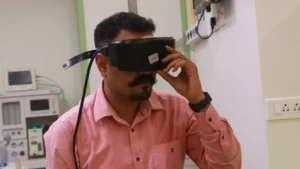Overview of Vertigo: A Comprehensive Introduction to Symptoms and Causes
When you have vertigo, you feel as though everything is spinning around you and that you might fall. We’ll provide a brief overview of vertigo in this blog post, including its causes, symptoms, remedies, preventative measures, and much more. Now let’s get started.
Understanding Vertigo

Image Source: Canva
What is Vertigo?
Vertigo is a specific type of dizziness where you feel as though you or your surroundings are moving or spinning. This sensation can range from mild to severe and may last for a few seconds, minutes, or even longer. While vertigo itself is not a disease, it’s often a symptom of various underlying health conditions.
Types of Vertigo
Vertigo can be categorized into two main types:
- Peripheral Vertigo: This type is related to problems in the inner ear or the vestibular nerve, which connects the inner ear to the brain. It’s the most common type of vertigo.
- Central Vertigo: This type is related to problems in the brain, particularly in the brainstem or cerebellum. Central vertigo is less common but can be more serious.
Symptoms of Vertigo
Recognizing the symptoms of vertigo is essential for proper diagnosis and treatment. Here are the common symptoms:
– Spinning Sensation: The hallmark symptom of vertigo is a feeling that you or your surroundings are spinning.
– Balance Problems: Difficulty maintaining balance, which can lead to unsteadiness or falls.
– Nausea and Vomiting: Often accompanying the spinning sensation.
– Abnormal Eye Movements (Nystagmus): Involuntary eye movements are commonly associated with vertigo.
– Headache: Frequently occurs, especially in cases related to migraines.
– Tinnitus: Ringing or buzzing in the ears, often linked to conditions like Meniere’s disease.
– Hearing Loss: Particularly in conditions affecting the inner ear.
Causes of Vertigo
The causes of vertigo are varied and can be classified based on whether they are peripheral or central in origin.
Peripheral Causes
- Benign Paroxysmal Positional Vertigo (BPPV): The most common cause, BPPV, is due to dislodged calcium particles (canaliths) in the inner ear.
- Meniere’s Disease: A chronic inner ear condition characterized by fluid buildup, leading to episodes of vertigo, tinnitus, and hearing loss.
- Labyrinthitis: Inflammation of the inner ear labyrinth, typically due to a viral infection, causing sudden severe vertigo.
- Vestibular Neuritis: Inflammation of the vestibular nerve, usually resulting from a viral infection, causing intense vertigo.
Central Causes
- Migraines: Vestibular migraines can lead to vertigo along with typical migraine symptoms.
- Multiple Sclerosis (MS): A chronic disease affecting the central nervous system, potentially causing vertigo if lesions affect the brain areas involved in balance.
- Stroke: Vertigo can be a symptom of a stroke, particularly those affecting the cerebellum or brainstem.
- Brain Tumors: Tumors in the brainstem or cerebellum can induce vertigo by pressing on balance-regulating areas.
Diagnosing Vertigo

Image Source: Canva
Accurate diagnosis is crucial for effective treatment of vertigo. The diagnostic process generally includes:
Medical History
A comprehensive medical history helps identify potential causes and risk factors. Key aspects include the onset, duration, and frequency of vertigo episodes, associated symptoms, and any recent infections or head injuries.
Physical Examination
A thorough physical examination, including tests for balance and eye movements, helps in diagnosing vertigo. Common tests include:
– Romberg Test: Assesses balance by having the patient stand with feet together and eyes closed.
– Head Impulse Test: Evaluates vestibular function by observing eye movements in response to quick head turns.
Hearing Tests
Audiometry tests are crucial for diagnosing conditions like Meniere’s disease or labyrinthitis by assessing hearing ability.
Imaging Tests
MRI or CT scans may be utilized to rule out central causes such as tumors or stroke, providing detailed images of the brain and inner ear structures.
Electronystagmography (ENG) and Videonystagmography (VNG)
These tests measure involuntary eye movements to evaluate inner ear function and detect abnormalities in the vestibular system.
Treatment Options for Vertigo

Image Source: Canva
Treatment for vertigo focuses on addressing the underlying cause. Common treatment approaches include:
Medications
- Antihistamines: Medications like meclizine and dimenhydrinate can reduce dizziness and nausea.
- Antiemetics: Drugs such as promethazine and ondansetron help control severe nausea and vomiting.
- Benzodiazepines: Medications like diazepam can alleviate severe vertigo symptoms.
- Diuretics: Used in Meniere’s disease to reduce fluid buildup in the inner ear.
Physical Therapy
- Vestibular Rehabilitation: Aims to improve balance and reduce vertigo through specialized exercises.
- Canalith Repositioning Maneuvers: Techniques like the Epley maneuver help move dislodged particles out of the inner ear in cases of BPPV.
Lifestyle and Home Remedies
- Hydration: Staying well-hydrated can help prevent dizziness.
- Avoiding Triggers: Identifying and avoiding specific triggers can reduce the frequency of vertigo episodes.
- Balance Exercises: Practices such as tai chi and yoga can improve overall balance and stability.
Surgical Options
In rare cases, surgery may be necessary:
- Labyrinthectomy: Removal of the inner ear labyrinth in severe Meniere’s disease cases.
- Vestibular Nerve Section: Cutting the vestibular nerve to reduce vertigo while preserving hearing.
Preventing Vertigo

While not all cases of vertigo can be prevented, certain strategies can reduce the risk and frequency of episodes:
- Stress Management: Techniques like meditation and deep breathing can help manage stress, a known trigger for vertigo.
- Regular Exercise: Maintaining physical fitness can improve balance and reduce vertigo risk.
- Healthy Diet: A balanced diet, low in salt and caffeine, can prevent fluid buildup in the inner ear.
- Regular Medical Check-Ups: Monitoring and managing underlying conditions like hypertension, diabetes, and migraines can help prevent vertigo.
When to Seek Medical Help

Image Source: Canva
Immediate medical attention is necessary for severe, sudden-onset vertigo, especially if accompanied by other symptoms such as headache, numbness, or difficulty speaking, which could indicate a stroke. Persistent or recurrent vertigo, hearing loss, or significant balance issues also warrant professional evaluation.
Living with Vertigo

Image Source: Canva
Living with vertigo can be challenging, but there are ways to manage it effectively. Here are some practical tips to help you navigate daily life and reduce the impact of vertigo episodes:
- Move Slowly: Avoid sudden head movements and change positions slowly to prevent triggering vertigo. When getting out of bed, sit up slowly and stay seated for a few moments before standing.
- Stay Hydrated: Dehydration can worsen vertigo symptoms, so make sure to drink plenty of water.
- Create a Safe Home Environment: Ensure your home is free of tripping hazards. Install handrails in bathrooms and along stairways, use non-slip mats, and keep pathways clear of obstacles.
- Practice Balance Exercises: Engage in activities like tai chi and yoga to improve your overall balance and stability.
- Educate Yourself and Others: Understanding vertigo and educating those around you can help reduce anxiety and improve management.
Conclusion
Vertigo is a multifaceted condition with various potential causes and symptoms. Understanding these aspects is essential for proper diagnosis and effective treatment. By recognizing the symptoms and seeking appropriate medical care, individuals with vertigo can manage their condition and improve their quality of life. If you experience vertigo, consult a healthcare professional to determine the best course of action and explore the various treatment options available.
By staying informed and proactive, you can navigate the challenges of vertigo and lead a fulfilling life. Remember, while vertigo can be disruptive, there are many resources and strategies available to help you manage it effectively.
FAQ’s
What is vertigo?
– Vertigo is a sensation of feeling off balance or spinning, which can be caused by various factors such as inner ear problems, infections, head injuries, and certain medications.
What are the common causes of vertigo?
– Common causes of vertigo include benign paroxysmal positional vertigo (BPPV), Meniere’s disease, vestibular neuritis, labyrinthitis, and migraines.
What are the symptoms of vertigo?
– Symptoms of vertigo include dizziness, spinning sensations, loss of balance, nausea, vomiting, and ringing in the ears.
How is vertigo diagnosed?
– Vertigo is typically diagnosed through a combination of medical history, physical exams, and diagnostic tests such as vestibular function tests, imaging studies, and blood tests.
What are the treatment options for vertigo?
– Treatment options for vertigo include vestibular rehabilitation therapy (VRT), canalith repositioning maneuvers, medications such as antihistamines and antiemetics, and surgery in some cases.
Can vertigo be cured?
– While some cases of vertigo can be cured, others may require ongoing management. The effectiveness of treatment depends on the underlying cause of the vertigo and the individual’s response to therapy.
How can I manage my vertigo symptoms?
– Managing vertigo symptoms involves a combination of lifestyle changes, medications, and physical therapy. This may include avoiding triggers such as sudden movements or changes in position, taking medications as prescribed, and engaging in physical therapy exercises to improve balance and reduce vertigo symptoms.
Can stress cause vertigo?
– Stress can worsen vertigo symptoms, but it is not a direct cause of vertigo. Other factors such as inner ear problems, infections, head injuries, and certain medications can contribute to the development of vertigo.
How can I prevent vertigo?
– Preventing vertigo involves avoiding triggers such as sudden movements or changes in position, managing stress, and maintaining good ear hygiene. It also involves taking medications as prescribed and engaging in physical therapy exercises to improve balance and reduce vertigo symptoms.
Can vertigo be treated with physical therapy?
– Yes, vertigo can be treated with physical therapy. Vestibular rehabilitation therapy (VRT) is a specialized form of physical therapy that can help improve balance and reduce vertigo symptoms.
